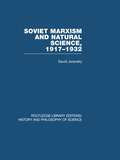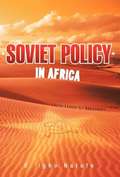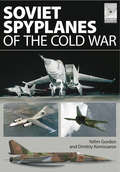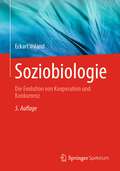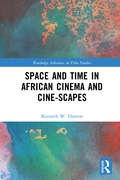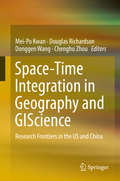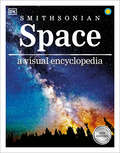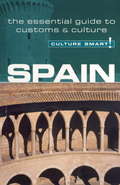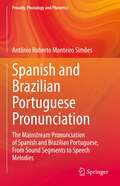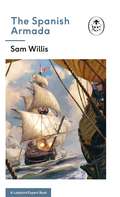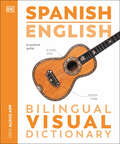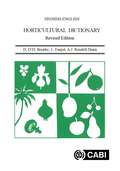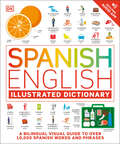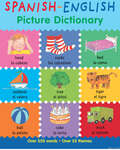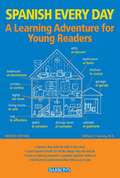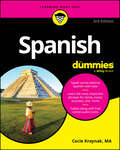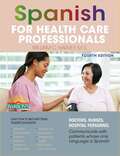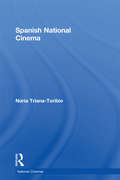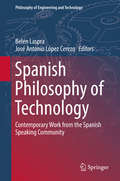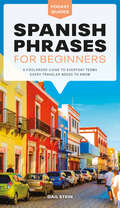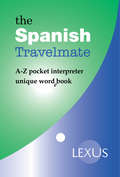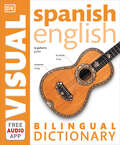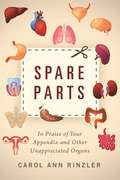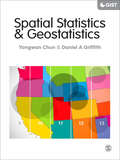- Table View
- List View
Soviet Marxism and Natural Science: 1917-1932 (Routledge Library Editions: History & Philosophy of Science)
by David JoravskyOriginally published in 1961. Russian Marxist philosophy of science originated among men and women who gave their whole lives to rebellion against established authority. The original tension within Marxist philosophy between positivism and metaphysics was repressed but not resolved in this first phase of Soviet Marxism. In this volume the author correlates the development of ideas with trends in the Cultural Revolution and against this background it is possible to understand why debates over general philosophy gave way to conflicts over specific sciences in the aftermath of the first Five Year Plan and why there was a genuine crisis in Soviet biology.
Soviet Policy in Africa: From Lenin to Brezhnev
by O. Natufe<p>Written by Soviet politics and international relations specialist Igho Natufe, Soviet Policy in Africa offers a critical analysis of Soviet and Western foreign policies that presents a balanced perspective on the understanding and evolution of Soviet ideology and politics. <p>Using on extensive research, Natufe traces the evolution of Soviet foreign policy from 1917 through 1980, focusing on the ideological constructs of Vladimir Lenin, the founder of the Soviet state, through the contending interpretations of Joseph Stalin, and finally to Nikita Khrushchev and Leonid Brezhnev. He reveals how the Soviets continually used the tenets of Marxism-Leninism for global issues, even though their interpretations sometimes varied between individual leaders. <p>Natufe also shows how the Soviet government viewed post-1945 Europe as favorable to revolutionary tendencies, particularly in the colonies. Africa became a battleground between Eastern and Western ideologies, and Soviet policies posed opportunities and threats to the continent's independence movements. In addition, Natufe discusses China and the West, as well as presenting case studies of Soviet foreign policy. <p>Scholars and students of international politics will find Soviet Policy in Africa a well-researched, thorough study of this often-overlooked subject.</p>
Soviet Spyplanes of the Cold War (FlightCraft)
by Yefim Gordon Dmitriy Komissarov&“A good look at the MiG-25 recce birds...Definitely recommended!&”—Cybermodeler &“Spy in the Sky&” matters have long been a source of fascination for aircraft enthusiasts, historians, and modelers, and none more so than the elusive and secretive Soviet types of the Cold War era. Here, Yefim Gordon presents a range of such types, in a collection of photographs, profiles, and line drawings together with supplementary text detailing the history of each craft, encompassing the various developmental milestones, successes, and pitfalls experienced along the way. The Soviet Union&’s two dedicated spyplane types, the Yakovlev Yak-25RV &“Mandrake&” (the Soviet equivalent of the Lockheed U-2) and the MiG-25R &“Foxbat&” are profiled, supplemented by details garnered from a host of original sources. Well-illustrated histories and structural analyses are set alongside detailed descriptions of the various plastic scale model kits that have been released, along with commentary concerning their accuracy and available modifications and decals. With an unparalleled level of visual information—paint schemes, models, line drawings and photographs—it is simply the best reference for any model-maker setting out to build a variant of this iconic craft.
Soziobiologie: Die Evolution von Kooperation und Konkurrenz
by Eckart VolandSoziobiologie ist den evolutionsbiologischen Ursprüngen und Gründen tierlichen und menschlichen Sozialverhaltens auf der Spur. In diesem Buch werden Strategien sozialer Konkurrenz, also Gewalt, Kampf und Dominanz behandelt, aber auch Kooperation, Altruismus und Solidarität. Die Interessen der beiden Geschlechtern sind Treibstoff der sexuellen Selektion. Kooperation ist also immer auch brüchiger Kompromiss im Kampf der Geschlechter zu verstehen. Außerdem geht es um die neuesten Erkenntnisse zur Evolution der Eltern/Kind-Verhältnisses und um ein Brutpflegeverhalten, das Kindesvernachlässigung und zugleich auch tief empfundene elterliche Zuneigung und Fürsorge möglich macht. Beschrieben wird, wie eine evolutionäre Perspektive auf das menschliche Verhalten zum modernen Menschenbild beiträgt. Das Buch richtet sich an Studierende und Lehrende der Biologie, Anthropologie, Psychologie und Sozialwissenschaften und an alle an der evolutionären Geschichte des menschlichen Sozialverhaltens Interessierte.
Space and Time in African Cinema and Cine-scapes (Routledge Advances in Film Studies)
by Kenneth W. HarrowThis book is the first of its kind to bring basic notions of contemporary physics to bear on African cine-scapes. In this book, renowned African cinema scholar Kenneth W. Harrow presents unique new ways to think about space and time in film, with a specific focus on African and African diasporic cinema. Through a series of case studies, he explores how cinema creates and represents time and space and, more specifically, how a cinema centered in African landscapes and figures accomplishes this. He reflects on the issues and problems posed by scientists when faced with the basic questions of what space and time are and their solutions or conclusions, giving both film studies and African studies scholars access to new ways to formulate their thinking about African cine-scapes. Working beyond the limits of a framework based in a postcolonial and cultural understanding of time and space, Harrow demonstrates how a scientific understanding of time and space can open up new approaches to African cinema and cinema in general. A unique, interdisciplinary book that encourages brand new ways to approach cinematic texts and, specifically, African cine-scapes.
Space-Time Integration in Geography and GIScience
by Mei-Po Kwan Douglas Richardson Donggen Wang Chenghu ZhouSpace-time analysis is a rapidly growing research frontier in geography, GIS, and GIScience. Advances in integrated GPS/GIS technologies, the availability of large datasets (over time and space), and increased capacity to manage, integrate, model and visualize complex data in (near) real time, offer the GIS and geography communities extraordinary opportunities to begin to integrate sophisticated space-time analysis and models in the study of complex environmental and social systems, from climate change to infectious disease transmission. This volume specifically focuses on research frontiers, comparative research, and research and application interactions in this field in the US and China, arguably the two most dynamic loci for this work today. The contributions to this book, by top researchers in China and the US, productively highlight the differences and similarities in approaches and directions for space-time analysis in the two countries. In light of the recent rapid progress in GIScience research on space-time integration in both countries, the book's focus on research frontiers in these two countries will attract great interest in both countries and in other parts of the world as well as among related disciplines. In addition, the book also explores the impact of collaborative research and publications underway in this area between the US and China and will provide an overview of these collaborative efforts and programs. This book will not only be of interest to university-based GIS researchers and students, but also to those interested in this new area of research and applications like researchers and developers in business, internet mapping and GIS and location based services (LBS).
Space A Visual Encyclopedia (DK Children's Visual Encyclopedias)
by DKFrom the Moon, Sun, and planets of our Solar System to space exploration, black holes, and dark matter, this completely revised and updated children&’s encyclopedia covers all you need to know about the cosmos. The most up-to-date images from space agencies such as NASA and ESA combine with info panels, timelines, interviews, diagrams, and activities you can do at home to help you understand the majesty and wonder of space. Learn about the Space Race, the Apollo Moon Landings, the Voyager craft that first probed the outer planets, the Hubble telescope, and the International Space Station (ISS) – the state-of-the-art laboratory orbiting Earth. Find out about future missions, space tourism, and the latest discoveries in the furthest reaches of our galaxy. Discover how to find constellations and where to look for stars and planets, including Venus and Mars, in the night sky. Learn how galaxies such as our Milky Way were formed. Part of a series of best-selling encyclopedias for children, Space: A Children&’s Encyclopedia is a rocket ride from the beginning of time to the near future, and from planet Earth out to the furthest reaches of the Universe.
Spain - Culture Smart!
by Marian MeaneyCulture Smart! provides essential information on attitudes, beliefs and behavior in different countries, ensuring that you arrive at your destination aware of basic manners, common courtesies, and sensitive issues. These concise guides tell you what to expect, how to behave, and how to establish a rapport with your hosts. This inside knowledge will enable you to steer clear of embarrassing gaffes and mistakes, feel confident in unfamiliar situations, and develop trust, friendships, and successful business relationships.Culture Smart! offers illuminating insights into the culture and society of a particular country. It will help you to turn your visit-whether on business or for pleasure-into a memorable and enriching experience. Contents include* customs, values, and traditions* historical, religious, and political background* life at home* leisure, social, and cultural life* eating and drinking* do's, don'ts, and taboos* business practices* communication, spoken and unspoken"Culture Smart has come to the rescue of hapless travellers." Sunday Times Travel"... the perfect introduction to the weird, wonderful and downright odd quirks and customs of various countries." Global Travel"...full of fascinating-as well as common-sense-tips to help you avoid embarrassing faux pas." Observer"...as useful as they are entertaining." Easyjet Magazine"...offer glimpses into the psyche of a faraway world." New York Times
Spanish and Brazilian Portuguese Pronunciation: The Mainstream Pronunciation of Spanish and Brazilian Portuguese, From Sound Segments to Speech Melodies (Prosody, Phonology and Phonetics)
by Antônio Roberto SimõesThis book contrasts variations in Spanish and Brazilian Portuguese pronunciation, using as a reference for discussion the mainstream careful speech of news anchors at the national level or the equivalent type of speech: a well-educated style that nonetheless sounds natural. Pursuing an innovative approach, the book uses this view of language as a cornerstone to describe and discuss other social and regional variants relative to that speaking register. It is aimed at speakers of Spanish interested in learning Portuguese and speakers of Portuguese who want to learn Spanish, as well as language specialists interested in bilingualism, heritage languages, in the teaching of typologically similar languages in contrast, and readers with interest in Phonetics and Phonology. The book employs a variety of innovative approaches, especially the reinterpretation of some of the traditional concept in Phonetics, and the use of speech prosodies and speech melodies, a user-friendly strategy to describe speech prosody in languages and speech melody in music through musical notation.
The Spanish Armada: A Ladybird Expert Book (The Ladybird Expert Series #30)
by Sam WillisPart of the ALL-NEW LADYBIRD EXPERT SERIES.____________Why did the Spanish launch their Armada on England?How did Francis Drake counter the Spanish threat?And why were so many ships lost at sea?In 1585 Spain was the most POWERFUL Empire in the known world.As tensions between PROTESTANT England and CATHOLIC Spain rose . . . SPAIN decided to INVADE ENGLAND. And launched the SPANISH ARMADA This raises the question: how did England manage to overthrow the Spanish invasion? Was it luck or judgement? Discover the answers and more inside Sam Willis's Ladybird Expert - The Spanish Armada, the thrilling and accessible account that explains what happened, who the key figures were and the tactics, triumphs and failures on both sides . . .
Spanish Diabetes Phrasebook
by American Diabetes AssociationThe only Spanish-English resource to help you communicate with your patients with diabetesWith more and more physicians, clinicians, educators, and administrators working with Latino and Hispanic patients, ensuring accurate communication is more important than ever. This handy pocket reference offers the Spanish equivalents to common phrases you use every day. From patient introductions to medical histories, examinations, and follow-up, you can provide a more trusting environment and quality care by engaging patients directly.Phrases are divided into nine, natural groups for ease of use. A glossary of related terms is included, Diabetes Spanish Phrasebook provides accurate communication, critical in all aspects of medical diagnosis, education, and general diabetes care to help you communicate more effectively with your Spanish-speaking patients.Written by the experts at the American Diabetes Association, the nation's leading voluntary health organization supporting diabetes research, information, and advocacy and the leading publisher of comprehensive diabetes information.Topics include:Greeting and IntroductionIdentifying the PatientMedications and AllergiesChief Complaint (CC)History of Present IllnessPast Medical HistoryReview of SystemsExaminationFollow-Up and PlanList of Relevant Terms
Spanish English Bilingual Visual Dictionary (DK Bilingual Visual Dictionaries)
by DKWith more than 6,750 fully illustrated words and phrases in Spanish and English, along with a free bilingual audio app, DK’s Spanish-English Bilingual Visual Dictionary is your essential companion to life in any Spanish-speaking country.You will learn all the words and phrases you need to buy food and clothes, talk about work and education, visit the doctor, go to the bank, use public transportation, and much more. Perfect for tourists, business travelers, and students, the dictionary is incredibly easy to follow, with thematically organized vocabulary so you can find closely related words on a particular topic. Words and phrases are illustrated with full-color photographs and artwork, helping to cement new vocabulary in your mind. A comprehensive, two-way index provides an instant reference point for new Spanish vocabulary.The supporting audio app enables you to hear all the words and phrases spoken out loud in Spanish. The app is easy to use and helps you learn, remember, and pronounce important vocabulary. The dictionary gives a pronunciation guide for every Spanish word, and you can use this alongside the app to perfect your pronunciation.
Spanish-English Horticultural Dictionary, Revised Edition
by D O'D Bourke Dr L Fanjul Dr Alexis J Rendell-DunnHorticulture is a significant industry in Spanish-speaking countries and countries with Spanish-speaking minority groups. This dictionary provides an authoritative source of horticultural terms in Spanish and their English equivalents. First published in 1987, it is compiled from a wide range of horticultural literature in the Spanish language, both temperate and tropical. Updated to include new terms, it covers technical terms, crop and pest names and related horticultural, agricultural, biological and botanical concepts. The dictionary includes temperate tree fruits and nuts, small fruits, viticulture, vegetables, ornamental plants, hops, industrial crops, and subtropical and tropical fruit and plantation crops. The names of diseases, pests and weeds of horticultural crops are included, accompanied by their scientific names. The genders of nouns are indicated throughout, as are feminine forms of adjectives and the plurals of certain words. Descriptions of plants are given where appropriate and English names where possible. It is essential for researchers, students and practitioners in horticulture in the various countries and regions where Spanish is spoken.
Spanish English Illustrated Dictionary: A Bilingual Visual Guide to Over 10,000 Spanish Words and Phrases
by DKOrganized by subject and with an accompanying audio app, this is the essential reference for all Spanish language learners.Learn more than 10,000 of the most useful words and phrases in Spanish with this beautifully illustrated dictionary for Spanish-language students. Building on the success of the English for Everyone course books and the Bilingual Visual Dictionary series, Spanish/English Illustrated Dictionary uses crystal-clear illustrations to show the meaning of over 10,000 words of Spanish vocabulary. The words are shown in a visual context in themed sections covering practical or everyday topics (such as shopping, food, or study), providing learners with all the vocabulary they need for work, travel, and leisure. Learning Spanish vocabulary is even easier with this visually stunning dictionary.
Spanish-English Picture Dictionary (First Bilingual Picture Dictionaries)
by Catherine Bruzzone Louise Millar Susan MartineauAre there kids in your life who want to learn Spanish? This is the perfect dictionary! Included are pages filled with bright and colorful pictures and bilingual labels to help teach Spanish words to English speaking children.Parents, teachers, and gift givers will find:350 illustrations of familiar objectsPictures labeled with the English word followed by its Spanish equivalentPhonetic spellings of Spanish wordsWords grouped by themesThis dictionary is a fun way for young English-speaking children to build a basic vocabulary in Spanish. It's never too soon to start teaching boys and girls a second language!
Spanish Every Day, 2nd Edition: A Learning Adventure For Your Readers
by William HarveyA Simon & Schuster eBook. Simon & Schuster has a great book for every reader.
Spanish For Dummies
by Cecie KraynakLearn to speak Latin American Spanish with confidence—the easy way Spanish For Dummies gets you started with the Spanish language, even if you've never learned a language before. The trusted Dummies language learning method is quick and practical, so you'll know what to say and do when traveling to a Spanish-speaking country or interacting with Spanish speakers in your community. You'll learn the basics of Spanish grammar and pronunciation, and then you'll explore common phrases you'll need in everyday situations. Get ready to study, work, or travel abroad—or integrate Spanish into your everyday life. This essential resource helps you make small talk, understand common expressions, navigate business settings, ask for directions, go to the doctor, and beyond. Learn how Latin American Spanish works—grammar, pronunciation, and important constructions Build your vocabulary and learn common expressions you'll hear while abroad Brush up your conversation skills with authentic dialogues, plus follow along with online audio Get practice reading, writing, and speaking Spanish, so you're ready to communicate effectively With Spanish For Dummies, students, travelers, and business professionals can gain the confidence to converse in Spanish.
Spanish for Health Care Professionals, 4th ed.
by William C. HarveyThis book is designed to help doctors, nurses, and medical assistants communicate in Spanish with Latino patients and their families who have little or no command of English. Fully updated text includes the addition of vocabulary for informing families about patients' medical care or death; instructing patients on how to navigate online forms; a sample disclosure and consent form in both Spanish and English; and a new section on working with medical interpreters. Every Spanish word in the book is followed by its phonetic pronunciation. The book also provides easy-to-follow tips on understanding colloquial spoken Spanish. Author William Harvey concentrates on words and phrases likely to be used in a medical setting. True-to-life dialogues dramatize situations pertaining to pregnancy, broken bones, pediatric care, heart and lung diseases, pharmacy prescriptions, and much more.
Spanish National Cinema (National Cinemas)
by Nuria Triana-ToribioThis study examines the discourses of nationalism as they intersected or clashed with Spanish film production from its inception to the present. While the book addresses the discourses around filmmakers such as Almodóvar and Medem, whose work has achieved international recognition, Spanish National Cinema is particularly novel in its treatment of a whole range of popular cinema rarely touched on in studies of Spanish cinema. Using accounts of films, popular film magazines and documents not readily available to an English-speaking audience, as well as case studies focusing on the key issues of each epoch, this volume illuminates the complex and changing relationship between cinema and Spanish national identity.
Spanish Philosophy of Technology
by Belén Laspra José Antonio López CerezoThis volume features essays that detail the distinctive ways authors and researchers in Spanish speaking countries express their thoughts on contemporary philosophy of technology. Written in English but fully capturing a Spanish perspective, the essays bring the views and ideas of pioneer authors and many new ones to an international readership. Coverage explores key topics in the philosophy of technology, the ontological and epistemological aspects of technology, development and innovation, and new technological frontiers like nanotechnology and cloud computing. In addition, the book features case studies on philosophical queries. Readers will discover such voices as Miguel Ángel Quintanilla and Javier Echeverría, who are main references in the current landscape of philosophy of technology both in Spain and Spanish speaking countries; José Luis Luján, who is a leading Spanish author in research about technological risk; and Emilio Muñoz, former head of the Spanish National Research Council and an authority on Spanish science policy. The volume also covers thinkers in American Spanish speaking countries, such as Jorge Linares, an influential researcher in ethical issues; Judith Sutz, who has a very recognized work on social issues concerning innovation; Carlos Osorio, who focuses his work on technological determinism and the social appropriation of technology; and Diego Lawler, an important researcher in the ontological aspects of technology.
Spanish Phrases for Beginners: A Foolproof Guide to Everyday Terms Every Traveler Needs to Know (Pocket Guides)
by Gail SteinLearn Español before you step off the plane! This beginner&’s book will make using Spanish phrases feel like second nature.This phrasebook is the perfect traveling companion for trips to Spain or any other Spanish speaking countries. You&’ll have everyday terms, popular idioms, conversational phrases, and pronunciation keys when you need them!Have you always wanted to visit Spain or South America? Now, you have a pocket guide that will help you with the phrases and terms you need to feel comfortable asking for directions, ordering food, or talking about the weather and sports. Everything a Traveler Needs to Know Gail Stein, an author of over 27 language books, has compiled Spanish Phrases for Beginners to introduce you to more than basic phrases. The book provides you with information on subtle differences between the peninsula and Latin America Spanish and modern additions such as commonly used social media and internet terms. This book is a foolproof guide to everything you need to know about common Spanish phrases and basic conversation starters. Visit Spanish speaking countries with confidence and excitement to explore. Complete the Series There are more books for beginners to discover in this series from DK Books. Pick up new hobbies and skills such as hand lettering through Hand Lettering for Beginners or learn language phrases through books such as Italian Phrases for Beginners.
The Spanish Travelmate
by Lexus Alicia de Benito Harland Mike HarlandThe Spanish Travelmate phrasebook and dictionary gives you a detailed yet easy-to-use A to Z list of English words and phrases with Spanish translations for quick-find reference. There are more than 3500 words and phrases, and the Spanish translations come together with an easy-to-read pronunciation guide. Tap a hyperlink (there are hundreds of them) to go to special sections: travel tips about being in Spain; basic language notes; typical Spanish replies to your Spanish questions; conversion tables. These are features which make the Travelmate the must-have ebook Spanish phrasebook download for the traveller who wants to really communicate. The Spanish Travelmate phrasebook and dictionary also gives you a detailed Spanish menu reader of over 500 items and a dictionary section with translations of over 300 common Spanish signs and notices. This is the little book that's a big help. And a joined-up language experience.
Spanish–English Bilingual Visual Dictionary (DK Bilingual Visual Dictionaries)
by DKNewly revised and updated, the Spanish-English Bilingual Visual Dictionary is a quick and intuitive way to learn and recall everyday words in Spanish. The Spanish-English Bilingual Visual Dictionary introduces a range of useful current vocabulary in thematic order, using full-color photographs and artworks to display and label all the elements of everyday life — from the home and office to sport, music, nature, and the countries of the world — with panel features on key nouns, verbs, and useful phrases. The Spanish-English Bilingual Visual Dictionary features: A quick and intuitive way to learn and remember thousands of words. A complete range of illustrated objects and scenes from everyday life. Fast and effective learning for any situation, from home and office to shopping and dining out. Detailed index for instant reference. Handy size ideal for travel. The illustrations in the Spanish-English Bilingual Visual Dictionary provide a quick and intuitive route to learning a language, defining the words visually so it is easier to remember them and creating a colorful and stimulating learning resource for the foreign-language and EFL/ESL student.
Spare Parts: In Praise of Your Appendix and Other Unappreciated Organs
by Carol Ann RinzlerA tribute to the parts we can live without . . . or can we? This book sheds light on human body parts once considered extraneous but now with modern medicine and modern medical paraphernalia shown to play an important role in our healthful survival. With wit and research-honed wisdom, health writer Carol Ann Rinzler explains in layman's language why we need ?bonus” body parts such as: The appendix, once discarded as "the worm of the intestines,” but now believed to play an important role in our immune system The coccyx, a.k.a. the "tailbone,” once considered the remnant of a human tail, but now considered the keystone of the boney pelvic arch when muscles meet and stabilize our seating Wisdom teeth, that ?extra” set of molars for which many "evolved” human jaws lack accommodating space but still remain in place where we higher primates still follow a basic ?hard”diet that require extra chew power On the other hand, having highlighted the still-important parts, Rinzler adds a chapter on dispensables: parts with which we can indeed happily dispense. Along the way, Rinzler weaves in Darwin’s theories of evolution and shares insights on what the human body may be like millennia from now. Charles Darwin considered them extraneous, but this witty book sheds moderns scientific light on the Darwin Six —appendix, tailbone, third eyelid, wisdom teeth, external ear muscles, body hair—once considered useless, now known to be both valuable and interesting, plus a chapter on the true dispensables, parts with which we can indeed dispense. Along the way, best-selling author Rinzler weaves in Darwin's brilliant and ground-breaking theories of evolution and shares insights into what the human body may look like millennia from now.
Spatial Statistics and Geostatistics: Theory and Applications for Geographic Information Science and Technology (SAGE Advances in Geographic Information Science and Technology Series)
by Daniel A. Griffith Yongwan Chun"Ideal for anyone who wishes to gain a practical understanding of spatial statistics and geostatistics. Difficult concepts are well explained and supported by excellent examples in R code, allowing readers to see how each of the methods is implemented in practice" - Professor Tao Cheng, University College London Focusing specifically on spatial statistics and including components for ArcGIS, R, SAS and WinBUGS, this book illustrates the use of basic spatial statistics and geostatistics, as well as the spatial filtering techniques used in all relevant programs and software. It explains and demonstrates techniques in: spatial sampling spatial autocorrelation local statistics spatial interpolation in two-dimensions advanced topics including Bayesian methods, Monte Carlo simulation, error and uncertainty. It is a systematic overview of the fundamental spatial statistical methods used by applied researchers in geography, environmental science, health and epidemiology, population and demography, and planning. A companion website includes digital R code for implementing the analyses in specific chapters and relevant data sets to run the R codes.
